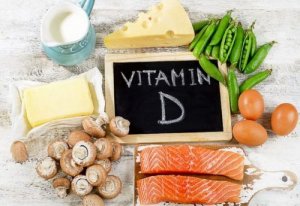The Importance of Vitamin D

Until recently, some believed the only function of vitamin D was to help the body absorb calcium and regulate its blood levels. In reality, it does so much more than that.
For athletes, it’s one of the best vitamins for maintaining and boosting performance. It also plays a crucial role in muscle recovery and in injury prevention.
Your body gets 80 percent of its required daily amount of vitamin D naturally through moderate sun exposure. Further, it gets the other 20 percent through some foods that should be a part of your daily diet.
Vitamin D and your skeletal system
Calciferol provides your skeletal system with its ideal density. It also helps prevent rickets in children and osteomalacia in adults.

Indeed, a lack of vitamin D greatly increases the risk of fractures and fissures. As such, elite athletes always keep a close eye on their levels. Not doing so would prevent them from performing certain sports that put a lot of stress on bones and joints.
Muscles, strength, and testosterone
Still, bones aren’t the only part of your body that need vitamin D. Muscles also depend on it for their growth and proper functioning.
What’s more, optimal levels of vitamin D have a positive impact on the production of testosterone. Indeed, this hormone has a direct impact on the size and strength of body tissue.
When there’s a lack of it, a person’s body fat has a tendency to increase. What’s more, it becomes out of control. As such, those who go to the gym to grow, define, and tone their muscles won’t see results unless they correct their levels.
The many benefits of vitamin D
For athletes, vitamin D is an essential element that fights exhaustion and chronic fatigue. Likewise, adequate levels help muscle recovery and regeneration after intense physical effort.
At the moment, there are studies investigating whether it plays a role in the risks of becoming overweight. Also, into its role regarding type 2 diabetes.

Other studies are looking at whether lower levels can be linked to episodes of dementia such as Alzheimer’s disease. What’s more, researchers have already proven its ability to prevent chronic illnesses such as breast, ovarian, and prostate cancer.
Risks due to a vitamin D imbalance
There’s a long list of issues that come with low levels of the fat-soluble vitamin. They include heart disease and a weakened immune system, osteoporosis, psoriasis, rheumatoid arthritis, tuberculosis, and a decline in cognitive function.
Further, a lack of it can also play a role in depression and seasonal affective disorders. It may even have the same impact on the brain as serotonin, the so-called “happiness hormone.”
However, the opposite can be just as dangerous. Excessive vitamin D can lead the body to deposit it in your lungs, tendons, and heart’s soft tissue.
Too much can also lead to kidney stones and irreversible kidney damage. Further, hypercalcemia (excess calcium in the blood) can develop, leading to confusion, disorientation, and arrhythmia.

You won’t develop vitamin D toxicity by spending too much time in the sun. The only cause is taking too many supplements. The first signs to appear may include nausea, vomiting, and constipation. Other symptoms to look for are lack of appetite, weakness, apathy, and sudden weight loss.
Read more: The Best Outdoor Sports and their Benefits
Sources of vitamin D
There are few foods that are rich in calciferol. Some include fish like salmon and tuna, as well as eggs, mushrooms, and beef liver. It’s common in some fortified foods like breakfast cereals, dairy products, and soy drinks.
Those who practice outdoor sports in the sun more than likely get enough vitamin D. In any case, make sure to protect yourself against UV rays by staying hydrated and use adequate sunscreen.
Until recently, some believed the only function of vitamin D was to help the body absorb calcium and regulate its blood levels. In reality, it does so much more than that.
For athletes, it’s one of the best vitamins for maintaining and boosting performance. It also plays a crucial role in muscle recovery and in injury prevention.
Your body gets 80 percent of its required daily amount of vitamin D naturally through moderate sun exposure. Further, it gets the other 20 percent through some foods that should be a part of your daily diet.
Vitamin D and your skeletal system
Calciferol provides your skeletal system with its ideal density. It also helps prevent rickets in children and osteomalacia in adults.

Indeed, a lack of vitamin D greatly increases the risk of fractures and fissures. As such, elite athletes always keep a close eye on their levels. Not doing so would prevent them from performing certain sports that put a lot of stress on bones and joints.
Muscles, strength, and testosterone
Still, bones aren’t the only part of your body that need vitamin D. Muscles also depend on it for their growth and proper functioning.
What’s more, optimal levels of vitamin D have a positive impact on the production of testosterone. Indeed, this hormone has a direct impact on the size and strength of body tissue.
When there’s a lack of it, a person’s body fat has a tendency to increase. What’s more, it becomes out of control. As such, those who go to the gym to grow, define, and tone their muscles won’t see results unless they correct their levels.
The many benefits of vitamin D
For athletes, vitamin D is an essential element that fights exhaustion and chronic fatigue. Likewise, adequate levels help muscle recovery and regeneration after intense physical effort.
At the moment, there are studies investigating whether it plays a role in the risks of becoming overweight. Also, into its role regarding type 2 diabetes.

Other studies are looking at whether lower levels can be linked to episodes of dementia such as Alzheimer’s disease. What’s more, researchers have already proven its ability to prevent chronic illnesses such as breast, ovarian, and prostate cancer.
Risks due to a vitamin D imbalance
There’s a long list of issues that come with low levels of the fat-soluble vitamin. They include heart disease and a weakened immune system, osteoporosis, psoriasis, rheumatoid arthritis, tuberculosis, and a decline in cognitive function.
Further, a lack of it can also play a role in depression and seasonal affective disorders. It may even have the same impact on the brain as serotonin, the so-called “happiness hormone.”
However, the opposite can be just as dangerous. Excessive vitamin D can lead the body to deposit it in your lungs, tendons, and heart’s soft tissue.
Too much can also lead to kidney stones and irreversible kidney damage. Further, hypercalcemia (excess calcium in the blood) can develop, leading to confusion, disorientation, and arrhythmia.

You won’t develop vitamin D toxicity by spending too much time in the sun. The only cause is taking too many supplements. The first signs to appear may include nausea, vomiting, and constipation. Other symptoms to look for are lack of appetite, weakness, apathy, and sudden weight loss.
Read more: The Best Outdoor Sports and their Benefits
Sources of vitamin D
There are few foods that are rich in calciferol. Some include fish like salmon and tuna, as well as eggs, mushrooms, and beef liver. It’s common in some fortified foods like breakfast cereals, dairy products, and soy drinks.
Those who practice outdoor sports in the sun more than likely get enough vitamin D. In any case, make sure to protect yourself against UV rays by staying hydrated and use adequate sunscreen.
All cited sources were thoroughly reviewed by our team to ensure their quality, reliability, currency, and validity. The bibliography of this article was considered reliable and of academic or scientific accuracy.
- McKenna, M. J., & Murray, B. (2014). Vitamin D deficiency. In Endocrinology and Diabetes: A Problem-Oriented Approach. https://doi.org/10.1007/978-1-4614-8684-8_23
- Prentice, A. (2008). Vitamin D deficiency: A global perspective. In Nutrition Reviews. https://doi.org/10.1111/j.1753-4887.2008.00100.x
- Gerenova, J. B. (2017). Vitamin D and Bone. Endokrinologya. https://doi.org/10.1016/B978-0-12-374602-3.00020-1
- Bertone-Johnson, E. R. (2009). Vitamin D and Breast Cancer. Annals of Epidemiology. https://doi.org/10.1016/j.annepidem.2009.01.003
- Christakos, S., Hewison, M., Gardner, D. G., Wagner, C. L., Sergeev, I. N., Rutten, E., … Bikle, D. D. (2013). Vitamin D: Beyond bone. Annals of the New York Academy of Sciences. https://doi.org/10.1111/nyas.12129
This text is provided for informational purposes only and does not replace consultation with a professional. If in doubt, consult your specialist.








